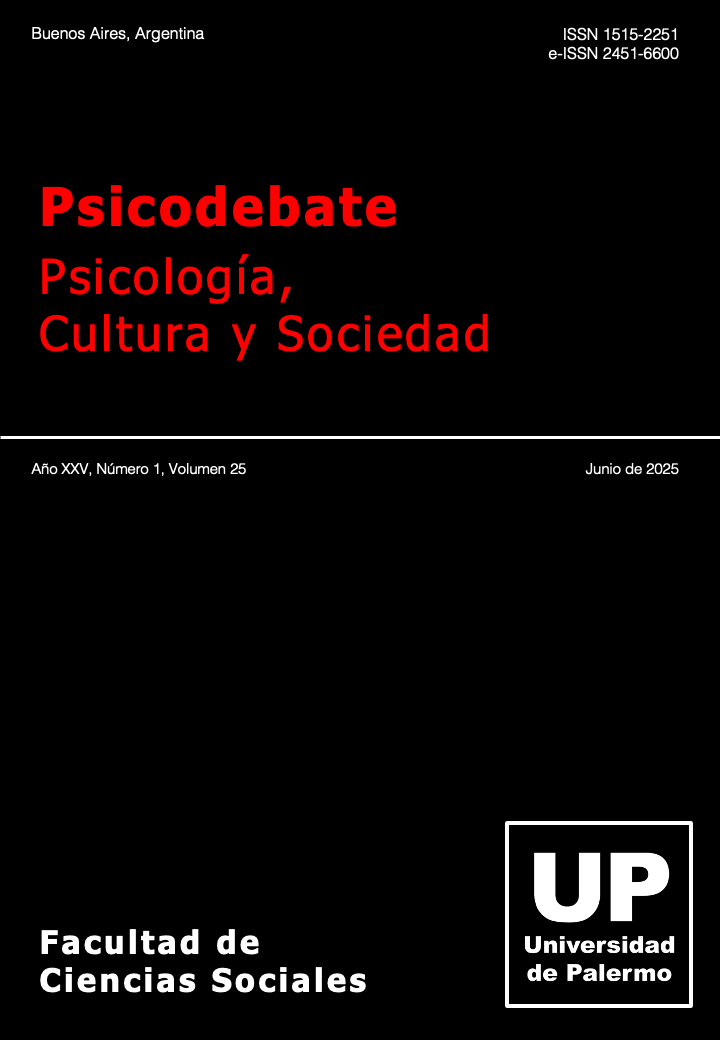Propiedades psicométricas de la Escala de Gaudibilidad para adultos de Morelia en población penitenciaria
Resumen
La gaudibilidad se define como el conjunto de moduladores que regulan el disfrute experimentado. Recientemente se generó una escala que mostró adecuadas propiedades psicométricas en población general. Sin embargo, no se han estudiado las propiedades psicométricas en Personas Privadas de Libertad (PPL). Por ello, el objetivo del presente trabajo fue estudiar la estructura interna y la confiabilidad de la Escala de Gaudibilidad para Adultos de Morelia (EGAM) en PPL. Se administró la EGAM a una muestra de 2,048 PPL con edades comprendidas entre 18 y 81 años (M = 35.7, DE = 10.2). Se aplicó un Análisis Factorial Confirmatorio (AFC) sobre la matriz de correlaciones policóricas, utilizando el método de estimación Diagonal Weighted Least Squares (DWLS) y errores estándar robustos. Asimismo, para el estudio de la confiabilidad se hizo uso de los índices de alfa de Cronbach y omega de McDonald. En los resultados destaca que el AFC corroboró parcialmente, χ²(169) = 947.17, p < .001, CFI = .97, TLI = .96, RMSEA = .07, SRMR = .06, el modelo de seis factores relacionados de la EGAM. Los índices de consistencia interna de los factores (los valores de alfa oscilaron de .75 a .65 y de Omega de .76 a .67) y de la escala total (alfa de Cronbach de .80 y un omega de McDonald de .67) fueron aceptables. También se ofrecen datos descriptivos en PPL de Michoacán (México). Se concluye que la EGAM es adecuada para evaluar la gaudibilidad en adultos PPL.
Descargas
Citas
Abad, F., Olea, J., Ponsoda, V., & García, C. (2011). Medición en ciencias sociales y de la salud. Síntesis.
Archuleta, A. J., Prost, S. G., & Golder, S. (2023). Psychometric properties of the WHOQOL-BREF in a population of older adults in prison: measuring quality of life in a carceral setting. International Journal of Prisoner Health, 19(4), 668-681. https://doi.org/10.1108/IJPH-07-2022-0042
Asociación Médica Mundial. (2024, 5 de marzo). Declaración de Helsinki de la AMM – Principios éticos para las investigaciones médicas en seres humanos. https://www.wma.net/es/policies-post/declaracion-de-helsinki-de-la-amm-principios-eticos-para-las-investigaciones-medicas-en-seres-humanos/
Bebbington, P., Jakobowitz, S., McKenzie, N., Killaspy, H., Iveson, R., Duffield, G., & Kerr, M. (2017). Assessing needs for psychiatric treatment in prisoners: 1. Prevalence of disorder. Social psychiatry and psychiatric epidemiology, 52, 221-229. https://doi.org/10.1007/s00127-016-1311-7
Berglund, J., Bjursell, C., & Hugo, M. (2025). Research on education in prisons: a scoping review. International Journal of Lifelong Education, 1-14. https://doi.org/10.1080/02601370.2025.2465740
Bucerius, S. M., Schultz, W., & Haggerty, K. D. (2023). “That shit doesn't fly”: Subcultural constraints on prison radicalization. Criminology, 61(1), 157-181. https://doi.org/10.1111/1745-9125.12327
Byrne, B. (2016). Structural equation modeling with Amos: Basic concepts, applications and programming. Routledge. https://doi.org/10.4324/9781315757421
Comisión Interamericana de los Derechos Humanos (2008, 3 al 14 de marzo). Principios y Buenas Prácticas sobre la Protección de las Personas Privadas de Libertad en las Américas. Organización de los Estados Americanos. http://www.oas.org/es/cidh/mandato/Basicos/PrincipiosPPL.asp
Crewe, B., & Laws, B. (2018). Subcultural adaptations to incarceration. En J. Woolredge & P. Smith (Eds.), The Oxford handbook of prisons and imprisonment (pp. 125–142). Oxford University Press. https://doi.org/10.1093/oxfordhb/9780199948154.013.6
Gómez-Hernández, E., Carrillo-Ramírez, E., & Padrós-Blázquez, F. (2020). Propiedades psicométricas de la Escala para medir el Disfrute Experimentado en Niños y Adolescentes (EDENA) en población de Michoacán (México). Psicogente, 23(43), 1-18. https://doi.org/10.17081/psico.23.43.3761
González-Cantero, J. O., González-Becerra, V. H., Ramírez-Zamora, L. M., Salazar-Estrada, J. G., Molina del Rio, J., Ortiz Sánchez, D., & Villegas-Ramírez, A. A. (2018) Gaudiebility and Psychopathological Symptoms in the Mexican Population. Psychology, 9, 925-933. https://doi.org/10.4236/psych.2018.95057
González-Cantero, J. O., González-Becerra, V. H., & Salazar-Estrada, J. G. (2019). Gaudiebility and health status perception in a Mexican sample. Acta Colombiana de Psicología, 22(2), 13-20. http://doi.org/10.14718/ACP.2019.22.2.2
Hildebrand, M., Wibbelink, C. J., & Verschuere, B. (2018). Do impression management and self-deception distort self-report measures with content of dynamic risk factors in offender samples? A meta-analytic review. International journal of law and psychiatry, 58, 157-170. http://doi.org/10.1016/j.ijlp.2018.02.013
Ignatyev, Y., Fritsch, R., Priebe, S., & Mundt, A. P. (2016). Psychometric properties of the symptom check-list-90-R in prison inmates. Psychiatry Research, 239, 226-231. https://doi.org/10.1016/j.psychres.2016.03.007
Kaypaklı, G. Y., & Tamam, L. (2019). Emotional Intelligence in Attention Deficit Hyperactivity Disorder. Current Approaches in Psychiatry/Psikiyatride Guncel Yaklasimlar, 11(5), 112. https://doi.org/10.18863/pgy.467037
Kline, R. B. (2015). Principles and practice of structural equation modeling. Guilford publications.
Kringelbach, M. L., & Berridge, K. C. (2009). Towards a functional neuroanatomy of pleasure and happiness. Trends in cognitive sciences, 13(11), 479-487. https://doi.org/10.1016/j.tics.2009.08.006
Kringelbach, M. L., & Berridge, K. C. (2010a). The functional neuroanatomy of pleasure and happiness. Discovery medicine, 9(49), 579-587.
Kringelbach, M. L., & Berridge, K. C. (2010b). The neuroscience of happiness and pleasure. Social Research, 77(2), 659 –678. https://doi.org/10.1353/sor.2010.0049
Ley Nacional de Ejecución Penal de 2016. (2016, 16 de junio). Cámara de Diputados del H. Congreso de La Unión. Diario Oficial de la Federación DOF 16-06-2016. http://www.diputados.gob.mx/LeyesBiblio/pdf/LNEP_090518.pdf
Magallón, M.T., Villegas, S., Martínez-Medina, M. P., & Padrós-Blázquez, F. (2018). Gaudibilidad en varones con y sin trastorno antisocial de la personalidad. Acta psiquiátrica y psicológica de América Latina 64(3), 168-175.
McFarland, S. G., & Sparks, C. M. (1985). Age, education, and the internal consistency of personality scales. Journal of Personality and Social Psychology, 49(6), 1692-1702. https://doi.org/10.1037/0022-3514.49.6.1692
Miller, J. D., Lamkin, J., Maples-Keller, J. L., Sleep, C. E., & Lynam, D. R. (2017). A Test of the Empirical Profile and Coherence of the DSM–5 Psychopathy Specifier. Psychological Assessment, 30(7), 870–881 https://doi.org/10.1037/pas0000536
Montgomery, W. (2009). Mindfulness y gaudibilidad: Categorías en terapia de conducta para tratar la evitación experiencial. Revista de Psicología de la Universidad Inca Garcilaso de la Vega, 1, 55-61.
Moral, J. (2006). El Análisis Factorial Confirmatorio (AFC). En R. Landero & M. González (Eds.), Estadística con SPSS y metodología de la investigación (pp. 445-528). Trillas.
Padrós, F., & Fernández-Castro, J. A. (2001). Escala de Gaudibilidad de Padrós. Una propuesta para medir la disposición a experimentar bienestar. Boletín de Psicología (Spain), 71, 7–28.
Padrós, F., & Fernández-Castro J. A (2008). A proposal to measure the disposition to experience enjoyment; "the Gaudiebility Scale". International Journal of Psychology and Psychological Therapy, 8(3), 413-430. https://doi.org/10.1037/t71439-000
Padrós-Blázquez, F., Domínguez-Espinosa, A. C., & Graff-Guerrero, A. (2018). La deseabilidad social como predictor del trastorno antisocial de la personalidad en reclusos. Revista Mexicana de Psicología, 35(2), 105-116.
Padrós-Blázquez, F., Herrera-Guzmán, I., & Gudayol-Ferré, E. (2012). Propiedades psicométricas de la escala de gaudibilidad en una población mexicana. Evaluar, 12,1-20. https://doi.org/10.35670/1667-4545.v12.n1.4693
Padrós-Blázquez, F., Martínez-Medina, M. P., & Cruz García, M. A. (2011a). Nivel de gaudibilidad en pacientes esquizofrénicos: un estudio piloto. Salud Mental (Mex), 34(6), 525-529.
Padrós-Blázquez, F., Martínez-Medina, M. P., González-Ramírez, V., Rodríguez-Maldonado, D., & Astals-Vizcaíno, M. (2011b). Estudio del nivel de gaudibilidad en pacientes con diagnóstico de trastorno por dependencia de sustancias. Psiquis, 20(2), 64-69.
Padrós-Blázquez, F., Martínez-Medina, M. P., & Graff-Guerrero, A. (2014). Gaudiebility Group Therapy in Depressed Patients: A Pilot Study. International Journal of Psychology and Psychological Therapy, 14(1), 59-69.
Padrós-Blázquez, F., Martínez-Medina, M. P., Graff-Guerrero, A., & Guardia-Olmos, J. (2021a). Propiedades psicométricas de la Escala de Gaudibilidad (Moduladores de Disfrute) para Niños y Adolescentes (EGNA). Anales de Psicología, 37(1), 69-76. https://doi.org/10.6018/analesps.392101
Padrós-Blázquez F., Martínez-Medina M. P., Montoya-Pérez K. S., & Montoya-Pérez R. (2021b). Psychometric properties of the Gaudiebility (Enjoyment modulators) Scale for Adults of Morelia (GSAM). PLoS ONE 16(7), e0252543. https://doi.org/10.1371/journal.pone.0252543
Padrós-Blázquez, F., Soria, V., Rafael, L. P., & Villegas, S., (2018). Rasgo antisocial y afecto positivo y negativo en población penitenciaria de México. Archivos de Criminología, Seguridad Privada y Criminalística, 6 (9), 143-151.
Petrides, K. V., Gómez, M. G., & Pérez‐González, J. C. (2017). Pathways into psychopathology: Modeling the effects of trait emotional intelligence, mindfulness, and irrational beliefs in a clinical sample. Clinical psychology & psychotherapy, 24(5), 1130-1141. https://doi.org/10.1002/cpp.2079
Sánchez-Teruel, D., & Robles-Bello, M. A. (2017). La gaudibilidad y el bienestar subjetivo en la salud: una revisión sistemática. Revista Latinoamericana de Psicología Positiva, 3(1), 11-23.
Sheldon, K. M., & King, L. (2001). Why positive psychology is necessary? American psychologist, 56(3), 216-217. https://psycnet.apa.org/doi/10.1037/0003-066X.56.3.216
Sociedad Mexicana de Psicología (2010). Código Ético del Psicólogo. Trillas.
Valdés-García, K. P., Sánchez-Loyo, L. M., Padrós-Blázquez, F., Ambriz-Delgadillo, L. E., & Hermosillo de la Torre, A. E. (2023). Gaudibilidad y depresión en estudiantes universitarios de Coahuila. Revista de psicología de la universidad autónoma del estado de México, 12, 31(3), 120-137. https://doi.org/10.36677/rpsicologia.v12i31.21447
Vázquez-Arias, M., & Padrós-Blázquez, F., (2023). Asociaciones entre Gaudibilidad y Susceptibilidad al Refuerzo Inmediato y Demorado. Revista de psicología de la universidad autónoma del estado de México, 12, 31(3), 33-48. https://doi.org/10.36677/rpsicologia.v12i31.21438
Ventura-León, J. L., & Caycho-Rodríguez, T. (2017). El coeficiente Omega: un método alternativo para la estimación de la confiabilidad. Revista Latinoamericana de Ciencias Sociales, Niñez y Juventud, 15(1), 625-627.
Wankel, L. M. (1993). The importance of enjoyment to adherence and psychological benefits from physical activity. International Journal of Sport Psychology, 24(2), 151-169.
Zamora-Cervantes, M., Martínez-Medina, M. P., & Padrós-Blázquez, F. (en prensa). Relación entre conductas alimentarias de riesgo y gaudibilidad. Psicología y Salud.
Derechos de autor 2025 Psicodebate

Esta obra está bajo licencia internacional Creative Commons Reconocimiento 4.0.
Los autores/as que publiquen en esta revista ceden los derechos de autor y de publicación a Psicodebate y aceptan el registro de su trabajo bajo una licencia de atribución de Creative Commons, que permite a terceros utilizar lo publicado siempre que de el crédito pertinente a los autores y a Psicodebate

















